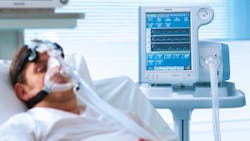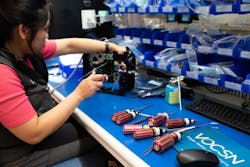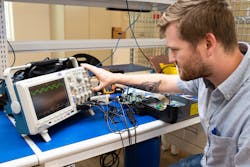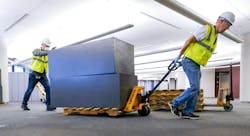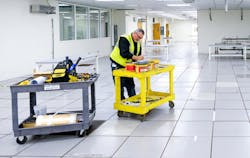Out of Breath: Ventilator Shortage Calls for Agile Innovation
The call for a coordinated effort to find fast answers has been issued in lockstep with calls for optimized care for those infected with COVID-19. To date, the number of global cases has surpassed 880,000, including more than 44,000 deaths, according to a Johns Hopkins tally.
Wreaking havoc on healthcare systems, the global surge is daunting—yet healthcare advocates, backed by government and industry, remain resolute that access to medical aid cannot be insurmountable. “Ignite the industrial might and innovation of the G20 to produce and distribute the tools needed to save lives,” urged WHO director-general Dr. Tedros Adhanom Ghebreyesus, during a virtual briefing with G20 leaders on March 26.
Heeding the global call to action, governments are asking manufacturers to repurpose production lines and supply chains as they try to keep up with the demand for the shortage of critical medical equipment such as ventilators in their jurisdictions. The Center for Health Security at Johns Hopkins estimates the United States currently has 160,000 mechanical ventilators, but would need 740,000 in the event of a “severe” pandemic.
Life-Critical Systems
Access to a ventilator could mean the difference between life and death for patients, said Dilshad Moosa, a Toronto-based registered respiratory therapist and certified respiratory educator. “Mechanical ventilators completely take over the work of breathing when the lungs have failed or are obstructed. When a SARS-COV-2 patient cannot breathe, he may need to be intubated. That means an endotracheal tube is pushed through the airway to help the patient breathe. The tube is connected to a ventilator, which pushes air to the lungs.”
Ventilators are sophisticated machines that come with hardware and software. In its simplest form, a mechanical ventilator consists of a pneumatically compressible air reservoir, oxygen supply, a set of valves and tubes and a breathing circuit.
The U.S. Food and Drug Administration took action on March 22 to amend the agency’s guidance for certain modifications to FDA-cleared devices during the COVID-19 pandemic. Usually, when manufacturers modify a ventilator device—such as adding wireless or Bluetooth capability—the modification can trigger an FDA premarket review. But given the urgency imposed by the pandemic, the FDA has eased the regulatory burden on manufacturers so they can add production lines or commence production at alternative sites.The FDA issued an Emergency Use Authorization (EUA) on March 27 allowing for emergency use of certain ventilators, anesthesia gas machines modified for use as ventilators, and positive pressure breathing devices modified for use as ventilators, along with accessories that meet specified criteria for safety, performance and labeling.
The FDA lists the following examples where modifications would not create undue risk while taking the public health emergency into account:
- Modifications to motors, batteries or other electrical components;
- Material changes to components in the gas pathway or with other patient tissue contact;
- Introduction of filtration to minimize aerosolization;
- Software modifications intended to modify the ventilation parameters including inspiratory pressure, tidal volumes, flow rates and positive end-expiratory pressure (PEEP), in accordance with any applicable device standard;
- Software modifications implementing physiological closed-loop (automated) algorithms for oxygen titration where the algorithms/devices are the subject of an FDA-approved Investigational Device Exemption (IDE);
- Hardware and software modifications implementing the capability for remote monitoring and remote adjustment of ventilator parameters (the adjustment of parameters by trained healthcare providers from outside an isolation unit to avoid unnecessary exposures).
In addition, the FDA urged that manufacturers implement appropriate cybersecurity controls and maintain device functionality and safety.
Automakers Team Up with Ventilator Makers
The temporary amendment gives license to non-medical device manufacturers, including automobile manufacturers, to both launch cooperative ventures and expand supply chains in support of high-volume production. Along with safety, reliability and power, these manufacturers will need to add speed to the list of prerequisites.
To this end, automakers are stretching their capabilities by retooling so they can come to the aid of global backorders for critical care ventilators; they are pledging to ramp up production by collaborating with medical technology companies and their supply chains, based on established design, as opposed to designing from scratch. New designs would need FDA approval, which would typically take time according to regulatory guidelines.
GM has teamed up with Ventec Life Systems to build VOCSN critical care ventilators at GM’s Kokomo, Ind. manufacturing facility, which supports the production of precision electrical components. Ventec and GM’s collaboration has culminated in the sourcing of more than 700 individual parts that are needed to build up to 200,000 VOCSN. The multi-function ventilator was FDA cleared in 2017 and integrates five separate devices, including a critical care ventilator, oxygen concentrator, cough assist, suction and nebulizer into a single portable device.
Ford Motor Company is on track to manufacture ventilators for General Electric’s health care division. GE Healthcare and Ford will work together to scale up production of a simplified design of GE Healthcare’s existing ventilator. GE also reports that GE Healthcare has doubled its capacity of ventilator production since the COVID-19 outbreak and, independent of its collaboration with Ford, plans to double production again by the end of Q2 2020.
For his part, Tesla CEO Elon Musk tweeted that the company had procured 1,255 FDA-approved ResMed, Philips and Medtronic ventilators from China. The lion’s share was delivered to hospitals in the Golden State, according to California Governor Gavin Newsom. Tesla is also collaborating with medical supply company Medtronic to produce lower-end ventilators at Tesla’s factory in Fremont, Calif.
Duty of Care
The FDA’s guidance has also been amended to allow hospitals and healthcare professionals to use ventilators intended for other environments. But some specialists warn that even with mass production, an important caveat remains: staffing.
Managing patients on mechanical ventilators requires critical care personnel—critical care physicians, nurses and respiratory therapists—to optimize the clinical outcomes, and Moosa points out that shortages of healthcare personnel could negatively impact the way additional ventilators are used during a large-scale public health emergency.
There are about 134,000 licensed respiratory therapists in the United States. Respiratory therapists must have a detailed understanding of the expected response when mechanical ventilation is applied.
As the numbers rise during the pandemic, the number of professionals who have the competency to operate mechanical ventilators is expected to fall short of the patient load.
Another concern is that the reliability of machines cannot be in question, said Moosa, pointing to an approach where a single ventilator is adapted to support multiple patients. The American Association for Respiratory Care (AARC), a non-profit professional organization, issued a statement advising clinicians against sharing mechanical ventilators because it cannot be done safely with current equipment.
According to the AARC, “The physiology of patients with COVID‐19‐onset acute respiratory distress syndrome (ARDS) is complex. Even in ideal circumstances, ventilating a single patient with ARDS and non-homogenous lung disease is difficult and is associated with a 40%‐60% mortality rate. Attempting to ventilate multiple patients with COVID‐19, given the issues described here, could lead to poor outcomes and high mortality rates for all patients cohorted.”
READ MORE: Splitting Hairs Over Ventilator Sharing
While statistical modelling signals a dire need for ventilators and hospitals are overwhelmed under the strain of a spike in COVID-19 cases, healthcare workers like Moosa fear that there may be too many choke points to contend with. “No matter how much production is ramped up, it may not be enough to keep pace.”
About the Author

Rehana Begg
Editor-in-Chief, Machine Design
As Machine Design’s content lead, Rehana Begg is tasked with elevating the voice of the design and multi-disciplinary engineer in the face of digital transformation and engineering innovation. Begg has more than 24 years of editorial experience and has spent the past decade in the trenches of industrial manufacturing, focusing on new technologies, manufacturing innovation and business. Her B2B career has taken her from corporate boardrooms to plant floors and underground mining stopes, covering everything from automation & IIoT, robotics, mechanical design and additive manufacturing to plant operations, maintenance, reliability and continuous improvement. Begg holds an MBA, a Master of Journalism degree, and a BA (Hons.) in Political Science. She is committed to lifelong learning and feeds her passion for innovation in publishing, transparent science and clear communication by attending relevant conferences and seminars/workshops.
Follow Rehana Begg via the following social media handles:
X: @rehanabegg
LinkedIn: @rehanabegg and @MachineDesign
